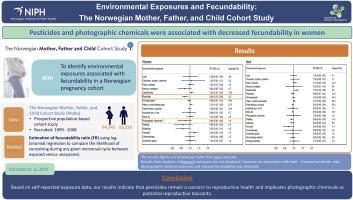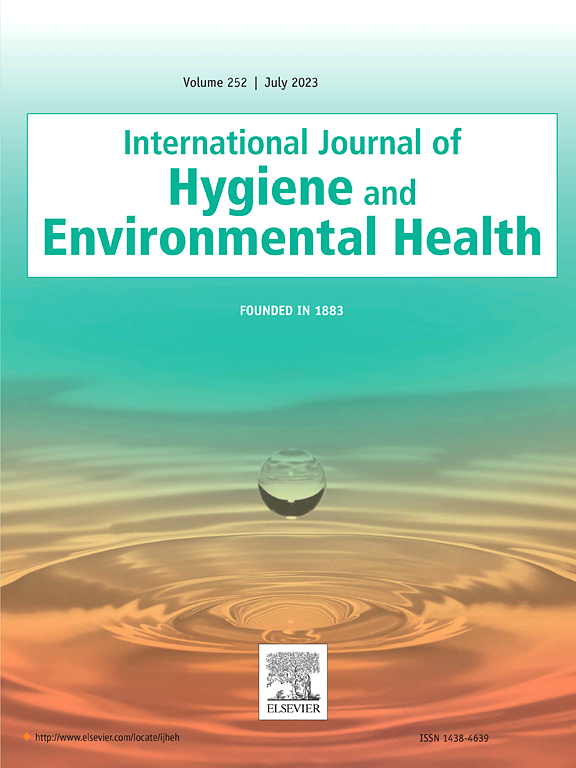Environmental exposures and fecundability: The Norwegian Mother, Father, and Child Cohort study
IF 4.5
2区 医学
Q1 INFECTIOUS DISEASES
International journal of hygiene and environmental health
Pub Date : 2024-11-22
DOI:10.1016/j.ijheh.2024.114492
引用次数: 0
Abstract
Previous studies have linked certain environmental exposures to reduced fecundability, influencing exposure recommendations. We continue to encounter numerous environmental exposures in our everyday lives, and further evidence is needed regarding their effects on fecundability. We evaluated associations between various self-reported environmental exposures and fecundability, measured as time to pregnancy, in 64,942 women and 53,219 men participating in the Norwegian Mother, Father, and Child Cohort study (MoBa). Women reported on 17, and men on 19, environmental exposures, including heavy metals, pesticides, paints, and radiation. Fecundability ratios (FR) were estimated using log-binomial regression, comparing likelihood of conception during a given menstrual cycle between exposed versus unexposed participants. About 50 % of women and 75 % of men reported minimum one environmental exposure. Exposure to any pesticide (FR 0.94 [95 % CI 0.91–0.98]), and frequent exposure to photographic chemicals (FR 0.84 [95 % CI: 0.73–0.96]), was associated with decreased fecundability in women. We also observed a tendency of a slightly higher fecundability among women and men exposed to disinfectants (FR 1.02 [95 % CI: 1.00–1.04] and 1.03 [95 % CI: 1.00–1.06], respectively). Our results suggests that exposure to pesticides and photographic chemicals could affect women's fecundability.

环境暴露与生育能力:挪威母亲、父亲和儿童队列研究。
以往的研究已将某些环境暴露与受精能力下降联系起来,从而影响了暴露建议。我们在日常生活中仍会遇到许多环境暴露,因此需要进一步的证据来证明它们对受孕率的影响。我们对参加挪威母亲、父亲和儿童队列研究(MoBa)的 64942 名女性和 53219 名男性的各种自我报告的环境暴露与受孕率(以怀孕时间来衡量)之间的关系进行了评估。女性和男性分别报告了 17 项和 19 项环境暴露,包括重金属、杀虫剂、油漆和辐射。采用对数二项式回归法估算受孕率(FR),比较暴露与未暴露的参与者在特定月经周期中受孕的可能性。约 50% 的女性和 75% 的男性报告至少接触过一种环境。接触任何杀虫剂(FR 0.94 [95 % CI 0.91-0.98])和经常接触照相化学品(FR 0.84 [95 % CI: 0.73-0.96])与女性受孕率下降有关。我们还观察到,接触消毒剂的女性和男性受孕率略高(FR 分别为 1.02 [95 % CI:1.00-1.04] 和 1.03 [95 % CI:1.00-1.06])。我们的研究结果表明,接触杀虫剂和照相化学品可能会影响女性的受孕能力。
本文章由计算机程序翻译,如有差异,请以英文原文为准。
求助全文
约1分钟内获得全文
求助全文
来源期刊
CiteScore
11.50
自引率
5.00%
发文量
151
审稿时长
22 days
期刊介绍:
The International Journal of Hygiene and Environmental Health serves as a multidisciplinary forum for original reports on exposure assessment and the reactions to and consequences of human exposure to the biological, chemical, and physical environment. Research reports, short communications, reviews, scientific comments, technical notes, and editorials will be peer-reviewed before acceptance for publication. Priority will be given to articles on epidemiological aspects of environmental toxicology, health risk assessments, susceptible (sub) populations, sanitation and clean water, human biomonitoring, environmental medicine, and public health aspects of exposure-related outcomes.

 求助内容:
求助内容: 应助结果提醒方式:
应助结果提醒方式:


